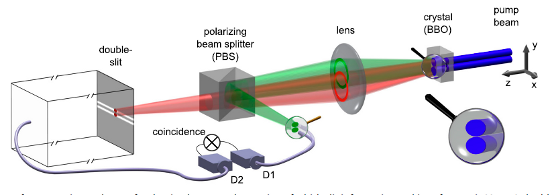In which we do a little ResearchBlogging, taking a look at a slightly confusing paper putting a new twist on the double-slit experiment. ———— I’m off to California this afternoon, spending the rest of the week at DAMOP in Pasadena (not presenting this year, just hanging out to see the coolest new stuff in Atomic,… Continue reading Single Photons Are Still Photons: “Wave-particle dualism and complementarity unraveled by a different mode”
Tag: optics
How Good Are Polarized Sunglasses?
A while back, I explained how polarized sunglasses work, the short version of which is that light reflected off the ground in front of you tends to be polarized, and by blocking that light, they reduce the effects of glare. This is why fishermen wear polarized sunglasses (they make it easier to see through the… Continue reading How Good Are Polarized Sunglasses?
What’s So Interesting About Extreme Lasers?
The second in the DAMOP research categories I talked about is “Extreme Lasers,” a name I was somewhat hesitant to use, as every time I see “Extreme [noun],” I get a flash of Stephen Colbert doing air guitar. It is, however, the appropriate term, because these laser systems push the limits of what’s possible both… Continue reading What’s So Interesting About Extreme Lasers?
What’s So Interesting About AMO Physics?
That’s the title of my slightly insane talk at the DAMOP (Division of Atomic, Molecular, and Optical Physics of the American Physical Society) conference a couple of weeks ago, summarizing current topics of interest in Atomic, Molecular, and Optical Physics. I’ll re-embed the slides at the end of this post, for anyone who missed my… Continue reading What’s So Interesting About AMO Physics?
Watching Photons Interfere: “Observing the Average Trajectories of Single Photons in a Two-Slit Interferometer”
It’s been a long and brutally busy week here, so I really ought to just take a day off from blogging. But there’s a new paper in Science on quantum physics that’s just too good to pass up, so here’s a ReasearchBlogging post to close out the week. Aw, c’mon, dude, I’m tired. What’s so… Continue reading Watching Photons Interfere: “Observing the Average Trajectories of Single Photons in a Two-Slit Interferometer”
Poll: Top Physics Story of 2010?
It’s the last week of the (calendar) year, which means it’s a good time to recap the previous twelve months worth of scientific news. Typically, publications like Physics World will publish a list of top ten physics stories of 2010, but we’re all Web 2.0 these days, so it seems more appropriate to put this… Continue reading Poll: Top Physics Story of 2010?
How Does Light Travel Through Glass?
I’ve mentioned before that I’m answering the occasional question over at the Physics Stack Exchange site, a crowd-sourced physics Q&A. When I’m particularly pleased with a question and answer, I’ll be promoting them over here like, well, now. Yesterday, somebody posted this question: Consider a single photon (λ=532 nm) traveling through a plate of perfect… Continue reading How Does Light Travel Through Glass?
The ABC’s of AMO Physics
Over at Confused at a Higher Level, Melissa offers an alphabetical list of essential supplies for a condensed matter experimentalist at a small college. This is a fun idea for back-to-school time, so I’ll steal it, and offer the following alphabetical list of essentials for Atomic, Molecular, and Optical physics at a small college, kind… Continue reading The ABC’s of AMO Physics
Bunches and Antibunches of Atoms: Hanbury Brown and Twiss Effects in Ultracold Atoms
Two papers in one post this time out. One of these was brought to my attention by Joerg Heber, the other I was reminded of when checking some information for last week’s mathematical post on photons. They fit extremely well together though, and both relate to the photon correlation stuff I was talking about last… Continue reading Bunches and Antibunches of Atoms: Hanbury Brown and Twiss Effects in Ultracold Atoms
What Do You Need to Make Cold Atoms? Part 2: Lasers and Optics
Following on yesterday’s discussion of the vacuum hardware needed for cooling atoms, let’s talk about the other main component of the apparatus: the optical system. The primary technique used for making cold atoms is laser cooling, and I’m sure it will come as no surprise that this requires lasers, and where there are lasers, there… Continue reading What Do You Need to Make Cold Atoms? Part 2: Lasers and Optics
